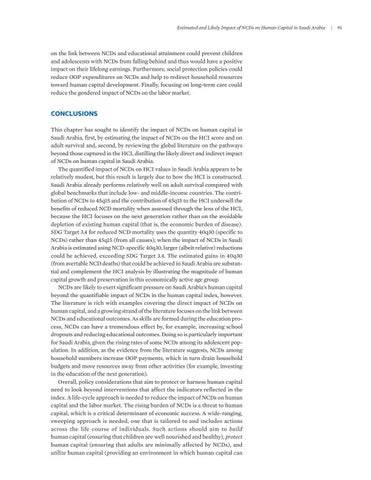Estimated and Likely Impact of NCDs on Human Capital in Saudi Arabia | 91
on the link between NCDs and educational attainment could prevent children and adolescents with NCDs from falling behind and thus would have a positive impact on their lifelong earnings. Furthermore, social protection policies could reduce OOP expenditures on NCDs and help to redirect household resources toward human capital development. Finally, focusing on long-term care could reduce the gendered impact of NCDs on the labor market.
CONCLUSIONS This chapter has sought to identify the impact of NCDs on human capital in Saudi Arabia, first, by estimating the impact of NCDs on the HCI score and on adult survival and, second, by reviewing the global literature on the pathways beyond those captured in the HCI, distilling the likely direct and indirect impact of NCDs on human capital in Saudi Arabia. The quantified impact of NCDs on HCI values in Saudi Arabia appears to be relatively modest, but this result is largely due to how the HCI is constructed. Saudi Arabia already performs relatively well on adult survival compared with global benchmarks that include low- and middle-income countries. The contribution of NCDs to 45q15 and the contribution of 45q15 to the HCI undersell the benefits of reduced NCD mortality when assessed through the lens of the HCI, because the HCI focuses on the next generation rather than on the avoidable depletion of existing human capital (that is, the economic burden of disease). SDG Target 3.4 for reduced NCD mortality uses the quantity 40q30 (specific to NCDs) rather than 45q15 (from all causes); when the impact of NCDs in Saudi Arabia is estimated using NCD-specific 40q30, larger (albeit relative) reductions could be achieved, exceeding SDG Target 3.4. The estimated gains in 40q30 (from avertable NCD deaths) that could be achieved in Saudi Arabia are substantial and complement the HCI analysis by illustrating the magnitude of human capital growth and preservation in this economically active age group. NCDs are likely to exert significant pressure on Saudi Arabia’s human capital beyond the quantifiable impact of NCDs in the human capital index, however. The literature is rich with examples covering the direct impact of NCDs on human capital, and a growing strand of the literature focuses on the link between NCDs and educational outcomes. As skills are formed during the education process, NCDs can have a tremendous effect by, for example, increasing school dropouts and reducing educational outcomes. Doing so is particularly important for Saudi Arabia, given the rising rates of some NCDs among its adolescent population. In addition, as the evidence from the literature suggests, NCDs among household members increase OOP payments, which in turn drain household budgets and move resources away from other activities (for example, investing in the education of the next generation). Overall, policy considerations that aim to protect or harness human capital need to look beyond interventions that affect the indicators reflected in the index. A life-cycle approach is needed to reduce the impact of NCDs on human capital and the labor market. The rising burden of NCDs is a threat to human capital, which is a critical determinant of economic success. A wide-ranging, sweeping approach is needed, one that is tailored to and includes actions across the life course of individuals. Such actions should aim to build human capital (ensuring that children are well nourished and healthy), protect human capital (ensuring that adults are minimally affected by NCDs), and utilize human capital (providing an environment in which human capital can

